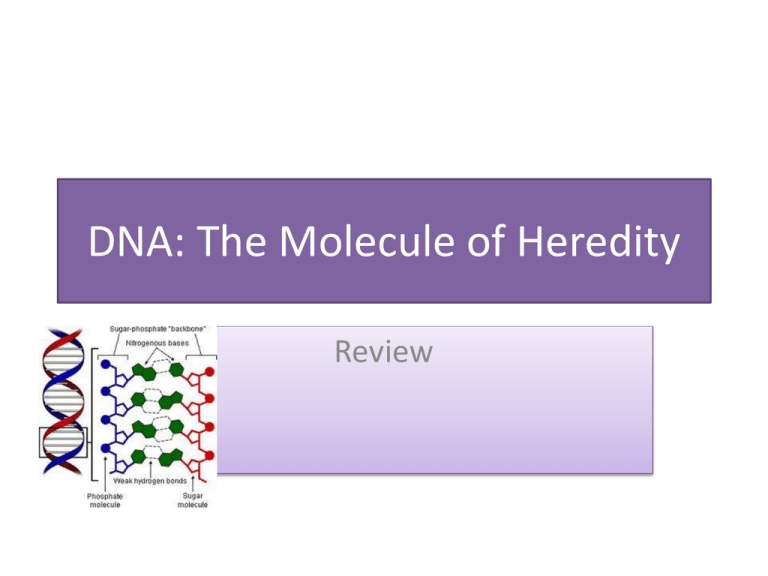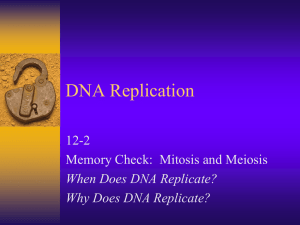DNA: The Molecule of Heredity
advertisement

DNA: The Molecule of Heredity Review Answer the Following • List the Functions of DNA • The single unit of DNA is called ______________ • DNA is located in which organelle of the cell? • What is the basic unit of DNA made up of? In all plant and animal cells, the nucleus contains long molecules of DNA. Which of the following best describes the function of DNA? a. DNA provides the shape and structure of the nucleus. b. DNA packages materials for transport through the nucleus. c. DNA carries materials into and out of the nucleus. d. DNA contains the blueprint for producing the whole organism. All of the following are found in a DNA molecule except — a. carbon dioxide b.deoxyribose c. nitrogen d.phosphate Which molecule is most responsible for determining an organism’s eye color, body structure, and cellular enzyme production? a. Complex starch b.Fatty acid c. Carbohydrate d.Deoxyribonucleic acid Name the four Nitrogenous base present in DNA • • • • 1. 2 3 4 Determine the complement strand of DNA for each strand shown below: ATACGCCCTTGAG _________________ GCCCTATATTGCG _________________ GTGTCCCAGGGG _________________ In DNA, which of the following determines the traits of an organism? a. Amount of guanine b.Number of sugars c. Sequence of nucleotides d.Strength of hydrogen bonds Erwin Chargaff studied the DNA of organisms within a single species. Chargaff discovered that the amount of adenine is about equal to the amount of thymine. Which of these explains why the ratio of adenine to thymine is nearly 1:1? a. Adenine and thymine pair with each other. b. Adenine binds with phosphates, while thymine binds with nitrates. c. Adenine and thymine are identical in chemical composition. d. Adenine bases contain a form of thymine. “Cytosine—guanine—thymine—guanine” describes — a. nucleotides within an RNA strand b. a sequence of bases within a DNA section c. points of DNA separation during protein synthesis d. tRNA codons for specific amino acids What do you mean by DNA Replication? • Replication takes place in the ___________ of the cell. Day 4 Notes “Steps of Replication” (record on page 5) 1. DNA unwinds and the two strands separate. 2. DNA polymerase (an enzyme) adds the complementary base pairs to each side. 3. Result: two identical molecules of DNA, each with one new and one old strand of DNA DNA molecules separate into single strands, which are then used to construct two identical strands of DNA. This process ensures that the — a. cytoplasm is in equilibrium b.mitochondria are genetically identical to the chloroplasts c. parent cells use little ATP d.daughter cells are genetically identical to the parent cells Question Which of the following best describes the question this set of procedures was designed to answer? a. Can a substance from dead bacteria transform living bacteria? b. Can R bacterial cells survive heating? c. Can dead bacterial cells confer immunity to a living host? d. Can bacterial cells be isolated from a healthy host? In Griffith’s experiment, what happened when heat-killed S-strain pneumococcus were injected into a mouse along with live R-strain pneumococcus? • A) DNA from the live R-strain was taken up by the heat-killed S-strain, converting them to R-strain and killing the mouse • B) DNA from the heat-killed S-strain was taken up by the heat killed R-strain, converting them to Sstrain and killing the mouse • C) Proteins released from the heat-killed S-strain killed the mouse • D) RNA from the heat-killed S-strain was translated into proteins that killed the mouse. • E) None of the above. If DNA of a certain organism has guanine as 35% of its bases. What percentage of its bases would be adenine? • • • • • 0% 15% 20% 30% 40% Which is not found in DNA? • • • • • Deoxyribose sugar. Adenine Phosphate group Phospholipid group Thymine If cytosine makes up 28% of the nucleotides in a sample of DNA from an organism, then adenine would make up what percent of the bases? • If cytosine makes up 22% of the nucleotides in a sample of DNA from an organism, then adenine would make up what percent of the bases? • 22 • 44 • 28 • 56 In DNA, phosphate groups bond to • • • • • Adenine Ribose Pyrimidine bases Other phosphate groups Deoxyribose Complementary base pairs are held together by • • • • • Peptide bonds Hydrogen bonds Disulfide bonds Covalent bonds Ionic bonds Semiconservative DNA replication means • • • • • The old DNA is completely broken down The old DNA remains completely intact A pairs with T and G pairs with C Only half of the DNA is replicated Each new DNA molecule has half of the old one. This experiment was conducted by the scientist __________ Complete • _________ worked with two strains of a bacterium, one pathogenic and one harmless. • ___________ were responsible for the discovery of the double helix structure of DNA • The phosphate group of one nucleotide is attached to the sugar of the next nucleotide by a _________ bond. Distinguish between • Purines and Pyrimidines • DNA and RNA Answer the Following • The model of DNA is known as a ____________________________ because it is composed of two ___________________ chains wrapped around each other. • What makes up the sides of a DNA molecule? • Name 2 purines. . Name 2 pyrimidines What makes up the "steps" of a DNA molecule? • What enzymes help separate the 2 strands of nucleotides on DNA? What bonds do • they break? • If the sequence of nucleotides on the original DNA strand was A – G – G – C – T – A, what would be the nucleotide sequence on the complementary strand of DNA? State what enzyme carries out the following functions during DNA replication. • A) Unwinds the helical DNA by breaking the hydrogen bonds between complementary bases. • b) Adds DNA nucleotides to the RNA primer. C). Digests away the RNA primer and replaces the RNA nucleotides of the primer with the proper DNA nucleotides. D) . Links the DNA fragments of the lagging strand together. • The DNA strand replicated in short fragments called Okazaki fragments is called the: • a. lagging strand b. leading strand Draw Neat labeled diagrams of • Structure of DNA • DNA Replication In double stranded DNA how do the four bases (C,A,T,G) pair up with each other. • C always pairs with T and A always pairs with G • A always pairs with T and C and G always pair with themselves • C always pairs with T and A and G always pair with themselves • A always pairs with T and C always pairs with G During DNA replication what is the first process to occur? • Sealing of the nicks between short DNA sections • Synthesis of the lagging strand • Unwinding of parental DNA • Synthesis of the leading strand DNA replicates through what process? • • • • Semi-conservative replication Dispersive replication Conservative replication Disparative replication Which of the following enzymes is not as involved in DNA replication as the others? • • • • Helicase DNA Polymerase DNA Ligase Phosphatase What is the function of DNA polymerase III? • It adds nucleotide pairs to the growing DNA strand • It adds single nucleotides to the growing DNA strand • It unwinds the DNA • It attaches the RNA primers to the DNA strand Choose the Correct Answer • Because DNA polymerase III can only act from 5' to 3', continuous strand growth can be achieved only along one of the template strands (Leading strand) and strand growth along the other strand must occur discontinuously resulting in the production of a series of short sections of new DNA called : Ο Replicon fragments Ο Okazaki fragments Ο Klenow fragments Ο None of the above • The enzyme that stitches Okazaki fragments together (along the lagging strand) is called : Ο DNA Ligase Ο DNA Polymerase II Ο Topoisomerase Ο Holoenzyme • The enzyme that creates a short RNA oligonucleotide at initiation sites where replication is to be carried out is called : Ο Primase Ο DNA Ligase Ο DNA Gyrase Ο Exonuclease • A major difference between DNA replication in prokaryotes and eukaryotes is : Ο there is only one replication origin in prokaryotes. Ο DNA amylase performs the function of DNA helicase in prokaryotes Ο replication is conservative in prokaryotes Ο prokaryotes do not use Topoisomerase in the replication process Good Luck • Make sure you go over the content in the text book and the worksheet including the lab worksheet (building a DNA model), and the quiz on DNA And DNA Replication






